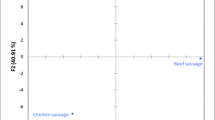Abstract
The aroma compounds in Blue cheese were studied with a dynamic headspace-GC/olfactometry (GC/O-DH) technique and evaluated by both aroma extract dilution analysis (AEDA) and the Osme technique to identify and assign importance to aroma compounds. AEDA aroma dilution values were obtained by sequential reduction of sample size, and Osme values were obtained based on aroma intensity and duration. The most important compounds contributing to Blue cheese aroma were diacetyl, 2-methylpropanal, 3-methylbutanal, ethyl butanoate, ethyl hexanoate, methional, dimethyl trisulfide, 2-heptanone, and 2-nonanone. Compounds central to the characteristic Blue cheese aroma and typically derived from milkfat included 2-heptanone, 2-nonanone, butanoic acid, hexanoic acid, and ethyl esters. Since the methyl ketones contributed the characteristic Blue cheese aroma, a flavor concentrate enriched in methyl ketones to impart characteristic Blue cheese aroma was synthesized using Penicillium roqueforti spores in a model system. A fivefold enhancement in methyl ketone production was obtained by providing aerobic conditions. The addition of sucrose and serine, compounds known to affect mold spore metabolism, did not enhance methyl ketone production but caused generation of an uncharacteristic fruity, floral aroma.
Similar content being viewed by others
References
Acree, T.E., J. Barnard, and D.G. Cunningham, A Procedure for the Sensory Analysis of Gas Chromatographic Effluents. Food Chem. 14:273–286 (1984).
Grosch, W., Detection of Potent Odorants in Foods by Aroma Extract Dilution Analysis, Trends Food Sci. Technol. 4:68–73 (1993).
McDaniel, M.R., R. Miranda-Lopez, B.T. Watson, N.J. Micheals, and L.M. Libbay, Pinot Noir Aroma: A Sensory/Gas Chromatographic Approach, in Proceedings of the 6th International Flavor Conference, Flavor and Off-flavors, Elsevier Science B.V., Amsterdam, 1990, p. 23.
Christensen, K.R., and G.A. Reineccius, Aroma Extract Dilution Analysis of Aged Cheddar Cheese, J. Food Sci. 60:218–220 (1995).
Milo, C., and G.A. Reineccius, Identification and Quantification of Potent Odorants in Regular-Fat and Low-Fat Mild Cheddar Cheese, J. Agric. Food Chem. 45:3590–3594 (1997).
Kubícková, J., and W. Grosch, Evaluation of Potent Odorants of Camembert Cheese by Dilution and Concentration Techniques, Int. Dairy J. 7:65–70 (1997).
Preininger, M., and W. Grosch, Evaluation of Key Odorants of the Neutral Volatiles of Emmentaler Cheese by the Calculation of Odour Activity Values, Lebensm. Wiss. Technol. 27:237–244 (1994).
Moio, L., and F. Addeo, Grana Padano Cheese Aroma, J. Dairy Res. 65:317–333 (1998).
Cadwallader, K.R., and H.H. Baek, Aroma-Impact Components in Cooked Tailmeat of Freshwater Crayfish (Procambarus clarkii), in Proceedings of the Ninth International Flavor Conference, George Charalambous Memorial Symposium, Elsevier Science B.V., Amsterdam, 1998, pp. 271–278.
Tomasini, A., G. Bustillo, and J.M. Lebeault, Fat Lipolyzed with a Commercial Lipase for the Production of Blue Cheese Flavor, Int. Dairy J. 3:117–127 (1993).
Kosikowski, F., and R. Jolly, Preparation of Blue Cheese Flavor, U.S. Patent 4, 133,895 (1979).
Kinsella, J.E., and D.H. Hwang, Biosynthesis of Flavors by Penicillium roqueforti, Biotechnol. Bioeng. 18:927–938 (1976).
Adda, J., J.C. Gripon, and L. Vassal, The Chemistry of Flavour and Texture Generation in Cheese, Food Chem. 9:115–129 (1982).
Molimard, P., and H.E. Spinnler, Compounds Involved in the Flavor of Surface Mold; Ripened Cheese: Origins and Properties, J. Dairy Sci. 79:169–184 (1996).
Barbieri, G., L. Bolzoni, M. Careri, A. Mangia, G. Parolari, S. Spagnoli, and R. Virgili, Study of the Volatile Fraction of Parmesan Cheese, J. Agric. Food Chem. 42:1170–1176 (1994).
Meinhart, E., and P. Schreier, Study of Flavor Compounds from Parmigiano Reggiano Cheese, Milchwissenschaft 41:689–691 (1986).
Kaneko, T., H. Suzuki, and T. Takahashi, Influences of Cellular Components and Redox Potential of Liquid Concentrated Culture of Lactobacillus bulgaricus on Acid-Producing Activity and Viability, J. Dairy Sci. 70:1128–1133 (1987).
Hugenholtz, J., M.J.C. Starrenburg, and A.H. Weerkamp, Diacetyl Production by Lactococcus lactis: Optimisation and Metabolic Engineering, Progr. Biotechnol. 9:225–228 (1994).
Dartey, C.K., and J.E. Kinsella, Metabolism of U-14C Lauric Acid to Methyl Ketones by the Spores of Penicillium roqueforti, J. Agric. Food Chem. 21:933–936 (1973).
Okumura, J., and J.E. Kinsella, Methyl Ketone Formation by Penicillium camemberti in Model Systems, J. Dairy Sci. 68:11–15 (1985).
Author information
Authors and Affiliations
Corresponding author
About this article
Cite this article
Qian, M., Nelson, C. & Bloomer, S. Evaluation of fat-derived aroma compounds in blue cheese by dynamic headspace GC/Olfactometry-MS. J Amer Oil Chem Soc 79, 663–667 (2002). https://doi.org/10.1007/s11746-002-0540-4
Received:
Accepted:
Issue Date:
DOI: https://doi.org/10.1007/s11746-002-0540-4




